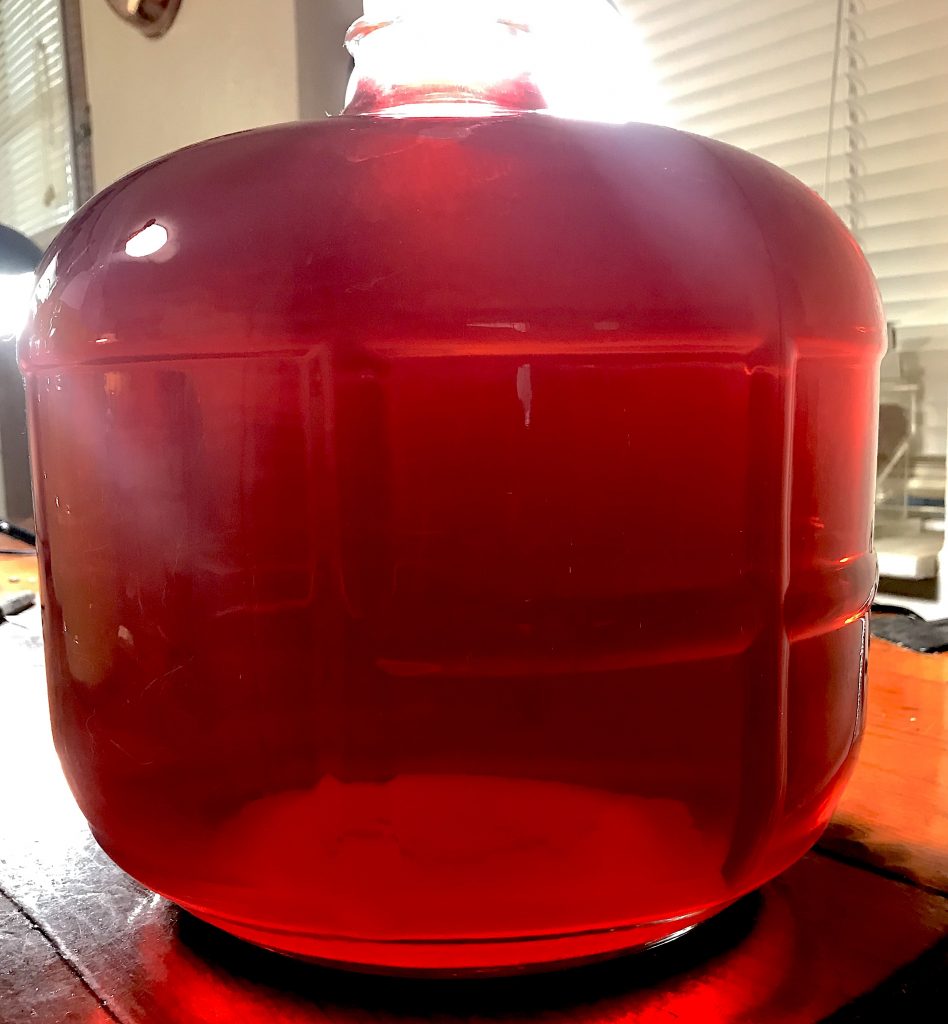
Two and a half gallons of Jambul Wine before racking. Photo by Green Deane
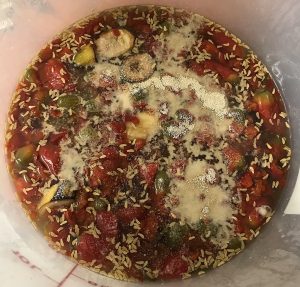
Fermenting ripe Tindora into wine. This pizza-like photograph by Green Deane
Three reasons prompted me to resurrect my wine-making past: I had nothing to do when Covid hit, I saw a lot of fruit going to waste, and I could use several of these “country wines” in my foraging classes. Since April I have started Beautyberry Wine, Blueberry Wine, Loquat Wine, Pindo Palm Wine, Cactus Pad Wine, Coconut Wine, Mango Wine, Orange Wine, Lemon Wine, Lime Wine, Tangerine Wine, St. John’s Mint Wine, Pomegranate Wine, Roses Petal Champagne, Horsemint Wine, Jambul Wine, Juniper Berry Mead, Blackberry Wine, Blackberry Mead, Mushroom Wine, Star Fruit Wine, Pineapple Wine, Tomato Wine, Sumac Wine and Tindora Wine (aka Ivy Gourd, the latest experiment. I’m not a idle person.) I’ve also done a few standards along the way like Concord Grape, Chianti, Lambrusco and Watermelon Wine (It’s sweetish and I have 12 gallons of it so I will need help emptying the bottles.)
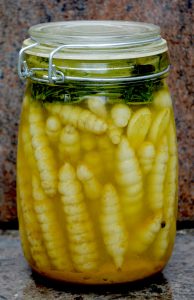
Pickled Florida Betony Roots. Photo by Green Deane
Like Lacto-fermentation (pickling) making wine follows a basic recipe: Material, water, sugar, yeast and time. (Making pickles it is material, water, salt, spices and a lot less time.) The Tindora Wine recipe, which I won’t know if it works until next year, took some decisions. When green Tindora tastes similar to a cucumber. Cucumbers are crispy water with a delicate flavor and aroma. A cucumber wine that tastes like cucumbers is hard to make. A strong yeast could destroy the flavor and aroma (exactly the same problem with Star Fruit Wine.) When Tindora is ripe it is more like a sweet red pepper with a different color and constituents altogether. So a yeast that treats delicate floral aromas was called for rather than a broad-shouldered one that eliminates character but produces 18% alcohol levels. I’m aiming for 12%, You need at least 8% alcohol to preserve any wine. Also what color will the final wine be? Guessing it will be a blush the sugar goal is slightly sweet so not a lot of sugar was added at the beginning. A little will be added at the end to reach a certain level of desired sweetness. Wine making is a lot of little decisions and keeping clean. One common question is if using wild fruit why not use wild yeast, after all that’s how it was done in the past.
Again, the issue is similar to making vinegar: Use wild or cultivated bacteria to pickle; use wild or cultivated yeasts to make wine. All fermenting bacteria and yeast do other things than just make acid or alcohol. They can “throw” flavors, good and bad because they can digest more than just the carbohydrates or sugar. They can also work too slowly letting worse bacteria or yeast to take over. They can under perform by not making enough acid or alcohol to preserve whatever you are fermenting. With wild yeast and bacteria you sometimes get a great performer but more often you get a poor one. Specifically bred yeast or bacteria do not improve your chances of success but they do reduce the number of things that can go wrong. I have an article and a video on collecting wild pickling bacteria here. I have the same for cider here and here. And lastly I started a Facebook page called Florida Wine, Bread and Beer where I post my fermenting exploits.

Classes are held rain or shine.
Unsettled weather this time of year makes schedule making weeks ahead of time a challenge and I’m trying to fit in some private classes as well. This weekend it’s classes in Orlando and Gainesville.
Saturday, October 24th, Blanchard Park, 10501 Jay Blanchard Trail, Orlando, FL 32817. 9 a.m to noon. Meet at the pavilion by the tennis courts by the YMCA building.
Sunday, October 25th, Boulware Springs Park, 3420 SE 15th St., Gainesville, FL 32641. Meet at the picnic tables next to the pump house. 9 a.m. to noon.
Sunday, November 1st, Dreher Park, 1200 Southern Blvd., West Palm Beach, 33405. Take exit 68 (Southern Boulevard) off Interstate 95 and go east. Entrance to the park is an immediate right at the bottom of the interstate bridge. Follow the convoluted signs to the science center (which is not where the GPS puts you.) Park anywhere. We meet 300 feet north of the science museum near the banyan tees. 9 a.m. to noon.
Saturday, November 7th, Bayshore Live Oak Park, Bayshore Drive. Port Charlotte. 9 a.m. to noon. Meet at the parking lot at Bayshore and Ganyard.
Sunday, November 8th, Mead Garden: 1500 S. Denning Dr. Winter Park, FL 32789. Meet near the bathrooms. The entrance to the park is off Denning not Pennsylvania as some GPS say.
To read more about the classes, to pre-pay or sign up, go here.
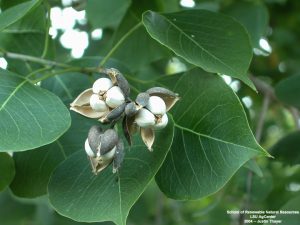
The Chinese Tallow tree is also called the Pop Corn Tree.
Is it edible? Yes, no, maybe… The Chinese Tallow tree is both banned and championed. It’s edibility is also linked to why it’s even in the United States to begin with. The tree was imported by none other than Ben Franklin (well… he sent some seeds to a friend.) The purpose was to use the white external seed fat for making candles which beef suet, tallow, was once used for. Hence the tree’s name in English. In theory that small coating of saturated fat on the outside of the seed is edible. It is also very stable. But there are two problems. It can be very difficult to remove and inside the seed there is an oil toxic to humans. So the fat and the oil should not mix. Some people have experimented with crushing the entire seed and heating the mash thus melting the saturated fat along with releasing the toxic oil. When they settle the edible fat and the non-edible oil are separated. In China, where the tree is valued, they steam the white saturated fat off. The tree, while an invasive species in some areas of North America — such as Florida — is being considered as a good candidate for bio-fuel. You can read my article about it here about it here. A later magazine article about the species is here.
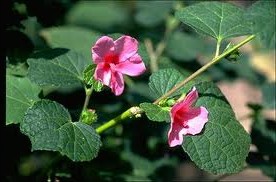
Caesarweed is in the hibiscus group.
Caesarweed is a common sight locally but right now it is being a seasonal extrovert and blossoming profusely. Like the Chinese Tallow tree above, Caesar Weed is another plant intentionally imported for industrial use, in its case making fiber for burlap bags and the like. It’s not strong enough to make a sturdy rope like Skunk Vine (which is also blossoming now and was imported to make rope.) But if thrown in water and allowed to rot for a few weeks long blast fibers are left over. The tasteless flowers are edible, the seeds can be ground and used like corn starch, and the leaves have medicinal uses besides being a famine food. They are hairy and upset the tummy. You can read about Caesar Weed here or see a video I did on it here.
We don’t have the opportunity to often use the word “windfall” in modern society as it was originally coined: A benefit caused by the wind literally knocking something down. Roman armies gathered wind-felled wood for their camp fires.
From a foraging point of view downed oaks don’t provide much windfall. Only the ones that were masting are of interest and they were already dropping acorns. But there are a couple of tree species worth investigating if they are blown over. One is pines. It’s an opportunity to harvest cambium and or nearly ripe cones for their seeds. It’s fairly easy to strip “fillets” off downed limbs or young trunks. And one does not have to climb the tree for the cones. A second tree worth investigating is the Chinese Elm. It’s used in landscaping intensely. During the Great Depression of the 1930’s they were planted by the millions and perhaps are the most intentionally planted tree outside of the lumber industry. A windfall of this species brings not only young leaves and samaras within reach but also provides easy access to the tree’s cambium which is edible. Every tree’s cambium grows differently and is the “living”part of the tree. It grows in two directions at once, in and out. The inner cambium become the wood of the tree. The outer cambium becomes the bark of the tree. This gives each tree it’s distinction wood and bark. And on the Chinese Elm (all Ulmus actually) and the pine (all Pinus) the cambium is edible.

Green Deane videos are now available on a USB.
Changing foraging videos: My nine-DVD set of 135 videos has been selling for seven years and are still available. They are the same videos I have on You Tube. Some people like to have a separate copy. A second option is a16-gig USB that has those 135 videos plus 15 more. While the videos can be run from the DVDs the videos on the USB have to be copied to your computer to play. They are MP4 files. The150-video USB is $99 and the 135-video DVD set is now $99. The DVDs will be sold until they run out then will be exclusively replaced by the USB. This is a change I’ve been trying to make for several years. So if you have been wanting the 135-video DVD set order it now as the price is reduced and the supply limited. Or you can order the USB. My headache is getting my WordPress Order page changed to reflect these changes. We’ve been working on it for several weeks. However, if you want to order now either the USB or the DVD set make a $99 “donation” using the link at the bottom of this page or here. That order form provides me with your address, the amount — $99 — tells me it is not a donation and in the note say if you want the DVD set or the USB.

Green Deane Forum
Want to identify a plant? Perhaps you’re looking for a foraging reference? You might have a UFO, an Unidentified Flowering Object, you want identified. On the Green Deane Forum we — including Green Deane and others from around the world — chat about foraging all year. And it’s not just about warm-weather plants or just North American flora. Many nations share common weeds so there’s a lot to talk. There’s also more than weeds. The reference section has information for foraging around the world. There are also articles on food preservation, and forgotten skills from making bows to fermenting food.
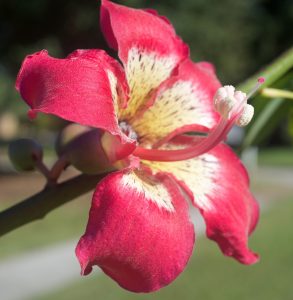
Silk Floss Tree Bossom. Photo by Green Deane
What people actually do with plants and what people write about what people do with plants can vary greatly. Ceiba’s (SAY-bah) are a good example. There are ten trees in the tropical genus. Various parts of various species are eaten variously which makes sense as the greater Mallow Family is generally user-friendly (unprocessed cotton seed oil and ephedrine in Sida being two exceptions.) Thus it is difficult to state specifically what is edible on each species Ceiba. The names can also vary in English from Silk Cotton to Silk Floss to Kapok and numerous native and Spanish versions. The seed oil is edible on some species as are buds, blossoms, and young leaves on others. Even the wood ash can be used as a salt substitute. But some caution is called for as the trees have also been used to treat numerous medical conditions internally and externally. There are two species in Dreher Park in West Palm Beach where the winters are mild. I’ve seen three Ceibas planted in Orlando. One is near the West Orange Bike Trail in Winter Garden and is about 30 feet tall. They are twice that in West Palm Beach. You can read a little more about the Silk Floss tree here.
This is weekly newsletter #428, If you want to subscribe to this free newsletter you can find the sign-up form in the menu at the top of the page.
To donate to the Green Deane Newsletter click here.

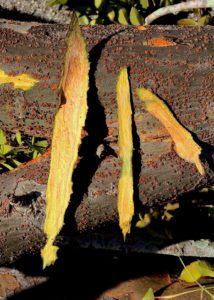

Green Deene: As a formerly avid zymurgist myself, I heartily recommend making a Sumac Bochet Mead. Of all the meads, Bochet is definitely the “cadillac.” A lot of folks are afraid of burning the honey during the raw honey boil, but it’s actually harder to burn than folks think. A deep brown carmelization is what you’re looking for. And you’ll likely have to add a bit of nitrogen to avoid a stuck ferment. PS I’ve been personally privileged to partake of a 60 year vintage Bochet – words do not suffice. Historically it was aged up to a century, improving every year.